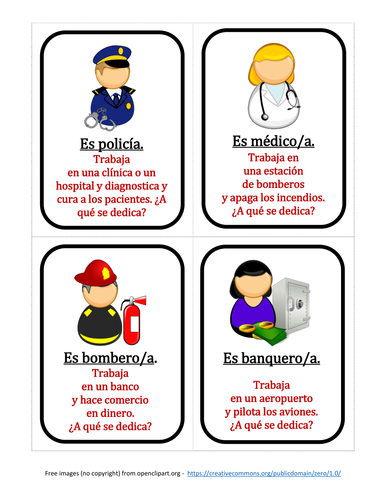


This game is designed to practice asking about and describing jobs in Spanish.
The vocabulary includes:
- jobs and occupations in masculine and feminine
- work places for all the jobs and occupations on the cards
- actions (verbs) related to the jobs and occupations on the cards
- the question ¿A qué se dedica?
There are two documents.
The first set contains a whole set made out of 36 cards, ideally for a group of 9 or 12 students.
The second set contains the same cards split into 2 smaller sets of 18 cards, as indicated by the different colour of the card borders. These are ideal if you want to split the class into two groups of 3 or 6 students. After they play with one set, the groups swap and play with the other too.
I-Have-Who-Has-Type of Game
This is an easy-to-play game and a great way to practice essential language concepts with the whole class. As students match up the answers on their cards with questions on other students’ cards, they get valuable practice with vocabulary and listening skills.
Directions:
Cut out the cards along the dotted line and laminate. For bigger classes, you might want to print more copies. of each set.
Give out all the cards in the set to the students. It is important to use all the cards.
Choose a student to go first. I usually do that by a counting rhyme (for example, En la casa de Pinocho, solo cuentan hasta ocho, 1,2,3,4,5,6,7,8)
Have the selected student read the question at the bottom of the card aloud and then put the card down.
The student who has the card with the answer then reads that answer aloud.
This student will then read the question at the bottom of their card and put the card down. Play continues in this fashion until all of the cards have been played. The game will end with the same student who started play.
Every card in the set is connected to a card before it and a card after it. To keep the game moving at a quick pace, all students need to pay attention to every question that’s asked. I tell my younger students that this is a magic game and that the magic only works if you pay attention, which is actually true. The magic happens in the end, when the question on the last card actually matches the answer on the very first card.
The vocabulary includes:
- jobs and occupations in masculine and feminine
- work places for all the jobs and occupations on the cards
- actions (verbs) related to the jobs and occupations on the cards
- the question ¿A qué se dedica?
There are two documents.
The first set contains a whole set made out of 36 cards, ideally for a group of 9 or 12 students.
The second set contains the same cards split into 2 smaller sets of 18 cards, as indicated by the different colour of the card borders. These are ideal if you want to split the class into two groups of 3 or 6 students. After they play with one set, the groups swap and play with the other too.
I-Have-Who-Has-Type of Game
This is an easy-to-play game and a great way to practice essential language concepts with the whole class. As students match up the answers on their cards with questions on other students’ cards, they get valuable practice with vocabulary and listening skills.
Directions:
Cut out the cards along the dotted line and laminate. For bigger classes, you might want to print more copies. of each set.
Give out all the cards in the set to the students. It is important to use all the cards.
Choose a student to go first. I usually do that by a counting rhyme (for example, En la casa de Pinocho, solo cuentan hasta ocho, 1,2,3,4,5,6,7,8)
Have the selected student read the question at the bottom of the card aloud and then put the card down.
The student who has the card with the answer then reads that answer aloud.
This student will then read the question at the bottom of their card and put the card down. Play continues in this fashion until all of the cards have been played. The game will end with the same student who started play.
Every card in the set is connected to a card before it and a card after it. To keep the game moving at a quick pace, all students need to pay attention to every question that’s asked. I tell my younger students that this is a magic game and that the magic only works if you pay attention, which is actually true. The magic happens in the end, when the question on the last card actually matches the answer on the very first card.
Something went wrong, please try again later.
This resource hasn't been reviewed yet
To ensure quality for our reviews, only customers who have purchased this resource can review it
Report this resourceto let us know if it violates our terms and conditions.
Our customer service team will review your report and will be in touch.
£3.00